| |
|
|
Opossums Rescue and Rehabilitation
|
| DO NOT TRY TO RAISE INFANT OPOSSUMS IF YOU DON'T KNOW WHAT YOU ARE DOING! THEY WILL DIE!!! IT IS ALSO ILLEGAL IN MANY STATES! FIND A WILDLIFE REHABILITATOR HERE! |
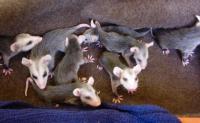 |
Most opossum babies end up orphaned, because their mother was hit by a car (their only real defense is to play dead...) or killed by dogs.
So PLEASE, if you care and you happen to hit an opossum with your car - accidents happen - take a minute and make sure that there are no babies on the animal, because they usually survive a lot within momma's pouch. After all, they are America's only Marsupials. |
|
 |
|
|
|
|
|
|
|
|
If you found an orphaned Opossum:
1. Check for injuries. Seriously injured babies should be taken to a veterinarian that day.
2. Warm the baby quickly if it feels cold
- Heating pad: Set temperature on low. Place the heating pad half under a closed box the baby has been placed inside of along with ravel-free cloths to snuggle with.
- Disposable plastic bottle: Use a plastic soft drink bottle or other plastic bottle. Fill it with hot water. Wrap it with a towel or other cloth. Place it inside a box with the baby. Make sure that it will not roll around possibly hurting the baby.
- Rice sock: Fill a sock 2/3 full of rice. Microwave it on high for 2 to 2 ½ minutes. Place it in the bedding in the box with the baby.
3. Treat dehydration. Give fluids by mouth using a 1 cc syringe, eye-dropper, or pet nurser. Offer the fluids at room temperature hourly for up to 6 hours. Do not exceed 12 hours. Any of the following fluids may be used and can be purchased at the grocery or drug store :
- Gatorade ( regular or clear flavors)
- Pedialyte (clear, no flavor)
- Sugar/salt water: 3 teaspoons Sugar, 1 teaspoon salt dissolved in 1 quart very warm water. Cool the water to room temperature before offering it to the baby.
4. Give it a warm box or pet carrier. Eyes closed infants and eyes open young that are in shock should be placed in a cardboard box or small/medium pet carrier with ravel-free bedding such as a few tee-shirts. Provide consistent source of warmth such as a heating pad on a low temperature setting. Place it half under the box or pet carrier.
5. Begin offering dilute formula. Make the formula as indicated in the diet section. Offer diluted formula every 2 hours using a 1 cc syringe, eye-dropper, or pet nurser. Syringes are better because there is less chance of aspiration. Give three feedings of 1 part formula / 2 parts water, then three feedings of 1 part formula/ 1 part water. If the baby does not develop diarrhea or bloat offer full strength formula at the recommended amounts and frequency for the age.
6. Provide food and housing as described below.
CAUTION: NEVER FEED COW'S MILK OR GOATMILK!
Formula:
Always begin new infants on dilute formula, and work up to full strength formula gradually. Feed 1 part full strength formula + 2 parts water every 4 hours until they can leap from the dish on their own. If at any time the infant develops diarrhea or bloating, cut back on the concentration of formula until the situation clears up. If such problems persist for more than 36 hours, seek medical advice.
How to feed:
Use a 1 cc syringe to feed formula. Wrap the baby in a cloth to keep it warm and secure. And hold it in a sitting-up position. Opossums rarely suckle a syringe but will lick from it. As soon as the babies are used to the formula, you may pour some in a shallow dish. Opossums learn to lap from a dish quickly. However, any baby not drinking well from the dish should continue to be hand fed until it is lapping from the dish and gaining weight.
WORD OF CAUTION: Even though you might find it cute and adorable to have your dog or cat to interact with your rescued opossum(s), please keep them apart from each other!!
Opossums NEED to be afraid of cats and dogs, because they are natural prey and predators. It is vital to their survival to keep this natural fear!
Stimulating urine and feces:
This should be done for babies whose eyes are closed or just opening. Use a slightly damp cotton ball or tissue to gently stroke the genital area. The baby should produce urine within a few seconds. Babies may not urinate or produce feces every time.
Self-feeding diet: Once the opossums teeth have fully emerged begin offering the self-feeding diet. The base chow (Science Diet) should be soaked in water to make it soft and easier to eat until they reach about 12 weeks of age when it can be offered dry. Formula should be poured over the soaked chow until the babies have been weaned from formula at 10 weeks of age.
Two shallow dishes of water should be offered . One dish for drinking and one for defecating.
- 90% of diet: Premium dog food (soaked in water until the opossums are older). (Pour formula over it until babies are weaned)
- 5% of diet: Fruits and vegetables cut in dime to nickel size pieces. Any fruit or vegetable may be used.
- 5% of diet: Insects such as crickets and worms, dead mice (cut up at first then left whole as babies get closer to release age).
- Supplements: Lightly sprinkle the food with a calcium/phosphate powder to help prevent calcium deficiencies after the baby is no longer receiving formula.
Natural foods: Add as many natural food items to the self-feeding diet as are available.
Infant Opossum Grow Chart:
- Birth - 1 Week: The infant is about the size of a dime and looks fetus-like. The hind legs are not developed but they have a special claw on their front legs for climbing into the pouch. There is nothing any human can do for them due to mouth being still being closed.
- 2 Weeks: Still tiny, almost embryonic, eyes and mouth closed. Sexes can be distinguished
- 3 Weeks: The hind legs and tail are recognizable. The infants make a sneezing sound when they inquire mom's attention.
- 4 Weeks: Weight is about 25 grams. First signs of skin pigmentation and fur growth.
- 5 Weeks: Whiskers begin to grow around the mouth.
- 6 Weeks: The fur begins to grow on the neck and back. Formula can be fed every 3 hours at this stage.
- 9 Weeks: Weight is about 30 grams. Eyes and mouth are starting to open and they are more active.
- 10 Weeks: The infants are starting to regulate their own body temperature (but still need that heating pad!) and should start to lap from a shallow dish. Feed formula 4 times a day.
- 11 Weeks: Offer small pieces of soft food and yogurt.
- 12 weeks: Move to a larger cage to allow climbing and exploring. The infants are making clicking sounds to communicate with each other.
- 13-14 Weeks: They have all their teeth and should be weaned. Can thermoregulate well.
- 15 Weeks: They will growing fast and are ready to start spending time outdoors in an enclosure or habitat.
- 20-22 Weeks: Time for their release back into the wild.
Releasing hand-raised opossums
Opossums should be ready for release at 20 to 22 weeks of age. Prior to release, your opossums should have been in a large outdoor cage for at least two weeks, preferably longer. They should be acclimated to weather changes, outdoor noises and the sights and sounds of the world. They should be properly shy of dogs, cats and humans ( EVEN YOU ). They must be familiar with their natural foods.
The release site should be outside the metropolitan area, on land with appropriate shelter, a constant water source and abundant natural food resources. There should be other opossums in the release area but it should not be overcrowded with them.
Since opossums are nocturnal (active by night), it is best to release them in the late afternoon to early evening. Release when good weather is forecast for at least 4-5 days and the last chance of freezing temperatures has passed. Ideally, their nestbox should be left at the release site, under some bushes, and back-up food provided for 4-5 days until they have located their natural food sources.
Keeping Babies Wild So They Can Go Back To The Wild
A great many baby opossums are orphaned every year. As babies, they are cute in an awkward way and will respond to their caregiver with affection. They are still wild animals though. Individuals raising orphaned babies must not treat them as pets. A baby opossum should be raised with at least one other opossum of similar age. This will aid in helping it revert to its true wild nature after being weaned.
Use good hygiene. Wash your hands after handling the babies and cleaning the cage. Wash bedding and dishes separate from your own. Disinfect bedding and dishes using 1 part bleach to 30 parts water. Allow bedding and dishes to soak for at least 15 minutes then rinse. The information in this paper is brief and intended for raising healthy orphans.
|
Opossum Facts
- North America's only marsupial (female has a pouch) mammal. The female carries and nurses her young in her marsupium until they are about 2 to 3 months old; then they are carried on her back another 1 to 2 months whenever they are away from the den.
- Size of a cat; grey to black fur; black eyes; pink nose, feet and tail; black ears; and pointed nose.
- Solitary and nocturnal: usually slow moving; when frightened and unable to flee may fall into an involuntary shock-like state, "playing 'possum".
- Hiss or growl and show their 50 sharp teeth when frightened; but, in reality, they are gentle and placid— they prefer to avoid all confrontations and wish to be left alone.
- Omnivorous: eats insects, snails, rodents, berries, over-ripe fruit, grasses, leaves, and carrion; occasionally will eat snakes, ground eggs, corn or other vegetables.
- Adaptable; able to live wherever water, food, and shelter exist. At home in trees; uses its prehensile tail to help stabilize position when climbing— it does not, however, hang by its tail.
- Few live beyond the age of 1 year in the environment; rare reports of living 5 to 10 years in captivity. Killed by many predators: humans (and cars), dogs, cats, owls, and larger wildlife.
- Opossums are solitary nocturnal animals, but may become diurnal in cold weather. They build the nests in tree hollows and spend most of their time there. Opossums don't hibernate, but remain inactive during severe frosts. Without nests Opossums are unable to survive.
|
 |
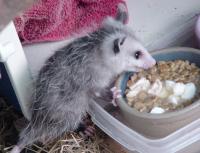
|
Sometimes they choose garages and attics as their temporary quarters because they are pushed out of their natural habitat and forced into closer proximity to people. In the wild Opossums have many predators: dogs, cats, owls, foxes, and other larger wildlife, but mostly Opossums suffer from humans and cars. In danger Opossums can feign death or drool heavily for a predator to think the Opossum is sick and unappetizing. Or they hiss and growl, showing sharp teeth, but it's only a bluff. These gentle and placid animals prefer to avoid confrontations. |
 |
|
Opossums have several ways of picking things up. Their back feet have opposable toes like the man's thumb. They can wrap the tail around things or hang on the tail, like monkeys do. They can also use their front feet for picking up things although they don't have opposable thumbs. Opossums don't have their own territory, but they are always on the move in search for food. Females stay in smaller areas while they can care for the youth. Opossums make clicking sounds during mating season or hiss and growl if threatened.
|
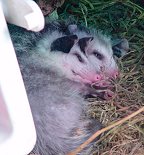
|
|
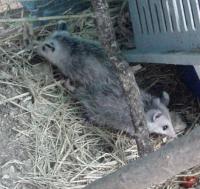
|
Opossums - Habitat
Opossums inhabit the United States east of the Rocky Mountains, Central America, and Pacific coastal North America. The Virginia Opossum is the only marsupial found in the North America. In South America and Australia there are about 80 species of Opossums. Opossums lived during the era of dinosaurs - fossil remains have been found from 70 million years ago.
|
 |
|
Opossums - Reproduction
The breeding season for Opossums begins in December and may continue through October with most of the infants born between February and June. Like all marsupials, Opossum females have a well-developed pouch. They produce an average of 7 young, once or twice a year (litters of 17 kids have been reported). At birth, the infants are hairless, embryonic-looking, and weigh about 0.1 grams because the period of gestation is 12-13 days and because they are born at a very early stage in their development.
|
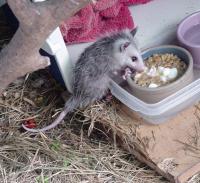
|
 |
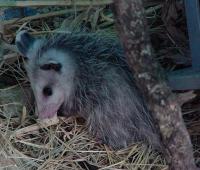
|
Young Opossums have to make a long and difficult journey from the birth canal into the pouch and latch onto a teat. The mother helps by licking the hair leading into the pouch. There are only 13 teats in the pouch and not all may be functional, so the excess infants will not survive. The young open the eyes at around 60-70 days and are weaned at about 100 days of age. Then they are often carried as they cling onto the mother's back. After separation from the mother, littermates may share common dens for some time. Very few young Opossums survive to become adults. |
 |
|
Opossums are considered to be furbearers, but they are not taken in large numbers because their pelt has little value. Opossums are nature's sanitation engineers; they eat road-kill, carrion, rotting fruits, and pests. Also Opossums are of great interest for scientists since they are the only marsupials in America, while Australian marsupials are driven to extinction by more modern mammals.
|
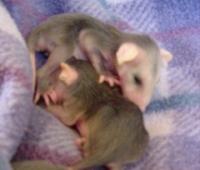
|
|
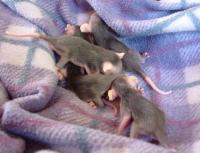
|
Weight: 9-13 lbs (4-6 kg). Some species reach only 300 gr.
Length: 15-20 inches (38-50 cm). Some species are 10-12 inches.
Life Span: 1-2 years in the wild, up to 10 years in captivity. |
 |
|
Opossums - Conservation
In the wild Opossums are closely linked with the ecology of the forests. Devastating fires destroy nest-sites and cause great declines in Opossums populations. Tall, straight trees favored by wild Opossums are highly valued for the production of timber. The technique of tree removing is very detrimental for all animals, including Opossums. The population crash has already begun and extinction of some species of Opossums in the South America and Australia is possible.
|
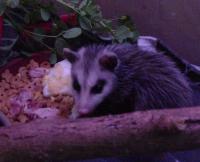
|
 |
|
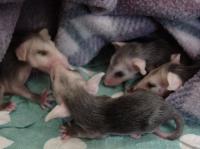
|
Opossums - Diet
Opossums don't have any methods for storing food or energy so they need stable food sources and that's why their diet is so varied. Opossums feed mostly on carrion. Other food sources for the Opossum include garbage, grass, leaves, insects, frogs, small birds and rodents, snakes, and earthworms. Opossums like to treat themselves with berries, seeds, flowers, and fruits and their favorites are persimmons, apples, and corn.
|
 |
| Photos |
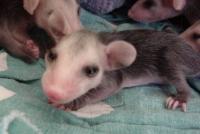
|
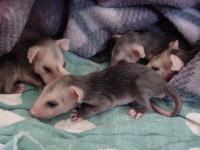
|
 |
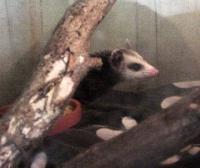
|
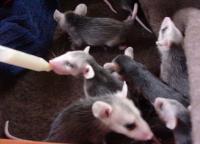
|
 |
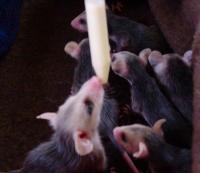
|
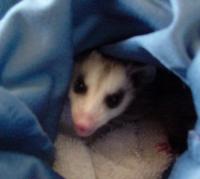
|
 |
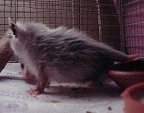 |
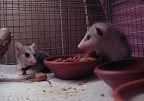 |
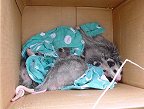 |
| Opossum with 3 legs, birth defect |
Dwarf Opossum with big 3-legged sister |
6 Opossums a minute before release |
REFERENCES
-
1. Fowler, Murray E. Zoo and Wild Animal Medicine, 2nd Edition. W.B. Saunders Co., Philadelphia, PA. 1986.
-
2. Harrison, Kit and George. America's Favorite Backyard Wildlife. Simon and Schuster, Inc. New York. 1985.
-
3.Martin, Alexander C., Zim, Herbert, Nelson, Arnold L. American Wildlife and Plants: A Guide to Wildlife Food Habits. Dover Publications, Inc. New York. 1951.
-
4. Marcum, Debbie. Substitute Milk Formulas for Opossum. Wildwood Farm 14206 FM2769. Leander, Tx. 78641-9109. 1988.
-
5. Marcum, Debbie. Stages of Development in Pouch Young of the Virginia Opossum. Wildwood Farm 14206 FM2769. Leander, Tx. 78641-9109. 1983.
-
6. Whitaker, John O. Jr. The Audubon Society Field Guide to North American Mammals. Alfred A. Knopf Publishing. NY. 1980.
-
7. White, Jan. Basic Wildlife Rehabilitation. International Wildlife Rehabilitation Council. Walnut Creek, CA 1988
|
|
|
|
|